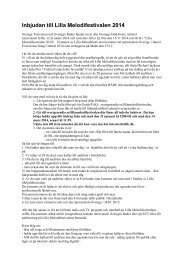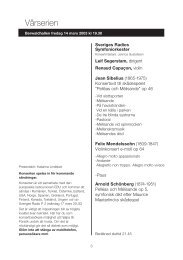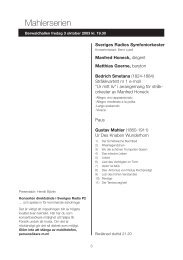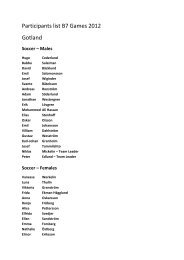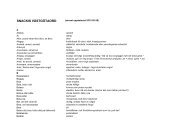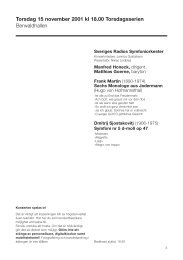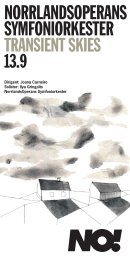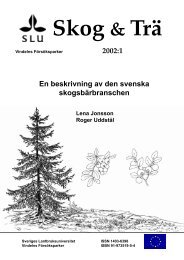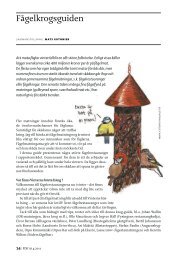SEMF 2013 Festivalprogram (pdf) - Sveriges Radio
SEMF 2013 Festivalprogram (pdf) - Sveriges Radio
SEMF 2013 Festivalprogram (pdf) - Sveriges Radio
You also want an ePaper? Increase the reach of your titles
YUMPU automatically turns print PDFs into web optimized ePapers that Google loves.
Fredag 7 juni<br />
Friday 7 June<br />
Lördag 8 juni<br />
Saturday 8 June<br />
Söndag 9 juni<br />
Sunday 9 June<br />
with Indian music. ”What we today term world music would hardly<br />
be possible without Ravi Shankar”, Anders Q Björkman wrote in<br />
the Swedish daily newspaper SvD shortly after his death. Shankar<br />
re ceived the Swedish Polar Prize in 1998, and was awarded a posthumous<br />
Lifetime Achievement Award at the Grammys in February<br />
<strong>2013</strong>. With this evening’s concert, <strong>SEMF</strong> wishes to celebrate Shankar’s<br />
work, and also highlight the Indian classical tradition as part of the<br />
world’s early music heritage.<br />
The origins of Indian classical music can be found in the Vedas,<br />
Hinduism’s oldest scriptures. The music is built on ragas, developed<br />
from liturgical songs and chants. A raga is a melodic framework, a<br />
combination of notes with specific rules around ascent and descent,<br />
and defines the shape of the music. Equally important, each raga<br />
lends itself to a certain mood, bringing with it a certain emotional<br />
content or colour. Rhythmically, the performance is also based on<br />
talas, rhythm cycles that specify the number of beats in each bar,<br />
how the beats are emphasised, and how bars are grouped together.<br />
The music is monophonic in nature and based around a single<br />
melody line, played over a fixed drone. Unlike its Western counterpart,<br />
Indian classical music uses just intonation tuning rather than<br />
an equal temperament tuning system. The sound also differs from<br />
Western classical major/minor tonality because the scales are built<br />
on micro-intervals, which means that an octave is divided into many<br />
more parts than the twelve semitones found for instance on a piano.<br />
Elaborate and expressive, Indian classical music places great<br />
em phasis on improvisation. It is spontaneous, created and performed<br />
in the here and now, and dependent on the season, the<br />
current atmo sphere, the artists’ mood, and the audience present.<br />
Con sequently, the programme for tonight cannot be announced<br />
in advance. Like ly ragas to be per formed are Yaman, Bageshri,<br />
Charukeshi, or Rageshri. The talas will be Rupak (seven beats),<br />
Teentaal (sixteen beats) or Ektaal (twelve beats). The raga is<br />
de veloped through several movements. The first, the alap, is a<br />
slow, serene, rhythmi cally free movement, pre senting the raga,<br />
expressing its mood and conveying its emotion. The second<br />
move ment, the jor alap, introduces the element of a rhythmic pulse,<br />
and has a tempo, but no rhythm cycle. The final un accompanied movement<br />
is the jor jhalla, an up-tempo movement making ex tensive<br />
use of the sitar’s top strings. After these initial three movements,<br />
the accompanying percussion instrument is introduced. The following<br />
accom panied movements are exposed through compositions<br />
called gats, set to various talas. The musicians start in a slow tempo,<br />
gradual ly building up to medium and fast gats. We will encounter<br />
two ragas, each played for around forty minutes.<br />
– Welcome to a concert guaranteed to be unique!<br />
FROM TEXTS BY SEEMA GULATI AND USTAD SHAHID PARVEZ KHAN<br />
Ustad Shahid Parvez Khan, sitar<br />
Atulkumar Upadhye, violin<br />
Mukesh Jadhav, tabla<br />
Jari Palmeri, tanpura<br />
För Ustad Shahid Parvez Khan är musiken inte en disciplin, utan<br />
livet självt. Han härstammar från sex generationer av sitar spelare<br />
och är en av de ledande företrädarna för Etawah Gharana, en<br />
musik alisk tradition eller ”familj” hängiven detta det mest kända<br />
av de indiska instrumenten. Han utbildades av sin far och guru,<br />
Ustad Aziz Khan. Vid tre års ålder tränades han först i den klassiska<br />
vokalmusik som utgör grunden för ”gayaki ang”, en typ av<br />
sitar spel som överför den mänskliga röstens känslo mässiga direkthet<br />
och klangnyans till instrumentet. Khan började uppträda<br />
offent ligt redan vid åtta års ålder. Uthållighet och hårt arbete har<br />
lett till en extraordinär teknisk skicklighet och Khan är idag allmänt<br />
erkänd som en av de främsta sitarspelarna i världen. Han<br />
13



